

Cleaning out the ol' mailbox
I don't know that there's a more wonderful feeling for an NHRA fan than the anticipation during race week when the NHRA POWERade Drag Racing Series is coming to your hometown. Man, you get to see all the cool cars and sleep in your own bed to boot! No luggage to pack and check, you can keep your shoes on the whole way there, no rental car lines … man, it's the life.
It doesn't hurt that the race that's coming here is going to decide two season championships and will be crammed with a lot of side drama – last races for Gary Scelzi and Tim and Kim Richards, Tony Schumacher's bid for yet another season record, etc. – so the countdown is on! I'm going to get a chance to meet some regular Insider readers at the event, which is always fun, and catch up with some old pals. The only bummer, of course, is that it's the last race of the season.
Tomorrow, Senior Editor Kevin McKenna and yours truly along with shutterbug Richard Wong will be covering the NHRA Softball Classic live from Arrowhead Credit Union Park. I'll be posting a rolling blog after each half inning, filled with play-by-play, quotes, and photos. It should be fun.
Before we head out, though, I want to clear out the ol' mailbag, which has been filling up with regularity.
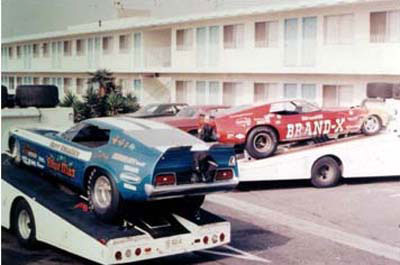 |
Q: Great piece on the history of OCIR. I was fascinated with the photos of the Funny Cars on the backs of the ramp trucks. We've all towed a race car on an open trailer, but what was it like for the Pro teams to do it crisscrossing the country? I'm sure bad weather, bugs, thieves, etc. were always a threat. Was there enough of a crew to do major cleanup after traveling thousands of miles? -- Scot Doyal,
A: I may not always have the answers, but I know where to get them, Scot. "Berserko Bob" Doerrer lived it as he traveled with "Jungle Jim" Liberman, and BB was kind enough to supply your answer.
"Good question, Scot. Weather was the biggest problem. Most teams had a custom-made cover to protect the engine and the exposed headers, but the car still rode out in the open. A few tried full car covers, but they got trashed by the wind after just a few weeks. I remember driving across country in 'Jungle's' ramp truck when we hit a monstrous thunderstorm. To protect the car, we pulled under an overpass to ride it out and camped out for the night. Back then, Funny Cars didn't have side windows, but 'Jungle' built a pair of temporary windows that were clamped in place while traveling, and it made a big difference in keeping the interior clean.
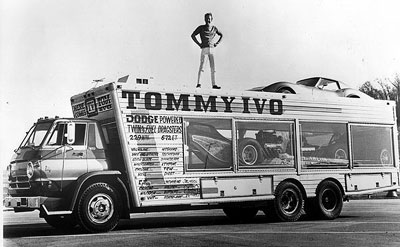 |
"The driver and two or three crew guys traveled on the road, and the chore everyone hated when they arrived at the track was cleaning the body. Bob Gerdes of Circus Custom Paint, who painted a lot of the Funny Cars back then, came up with a super-slippery clear coat that he applied to every car he painted. On top of that, we applied a heavy coat of Simoniz paste wax before we hit the road, and it made the cleanup a lot easier. The car was so slick that decals wouldn't stick to it! Most of the time, we'd pull somebody out of the crowd, give him (or her) a T-shirt and cleaning supplies and let them have at it.
"Thieves were another issue. For a while, entire rigs were being stolen out of hotel parking lots (ask Don Schumacher), and we all took turns sleeping in the truck's sleeper when we were parked to protect the rig. I don't know who was the first to modify a ramp truck to enclose the car -- I believe it was Tommy Ivo -- but a few years later, the box truck and crew-cab duallie with a gooseneck Chaparral trailer became the norm, replacing the venerable ramp truck."
Thanks, BB. Pictured here is the vehicle that Berserko was referencing, Ivo's glass-sided wonder.

 |
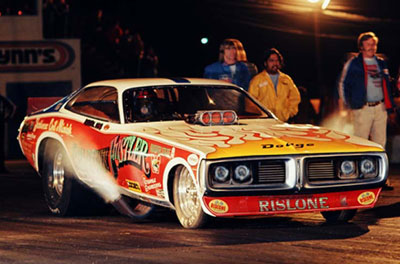 |
Q: Hi, Phil. In NHRA's Photos of the Week, in the attached pictures, there is one man with muttonchop sideburns who is standing behind the starting line. Sometimes he's at OCIR, other times he's at Irwindale. I don't think he's a crewmember for a specific car because he's standing there when various cars are running. In this first photo (Raymond Beadle, Irwindale, 1977), he's wearing white pants and standing right behind the starter. He's also in the background of this picture (Russell Long, Irwindale, 1977). He's not holding a camera, so he's not a photographer. I'm thinking he must be some NHRA official or maybe a writer for ND. Anyway, as I see these photos rotate across my screen, I am often wondering, 'Who the heck is that guy, and how is it that he's always lucky enough to be standing there?' I was wondering if the face looks familiar to you. -- Andy Perreault,
A: Good eye, Andy. He's a familiar face to us longtime SoCal race fans. That's longtime assistant starter Richard Schwartz, a mainstay at "the County" and "the Dale" and always there to back up Larry Sutton (the black-hatted guy in the Beadle pic). I did an interview with Sutton two weeks ago that I will share here very soon and asked him about Richard.
"The guy would give you his last piece of anything; if you needed him, he'd drop whatever he was doing and come help you," he said. "He was an incredible man, and we miss him."
Richard died probably 10 years ago of a brain aneurysm but is fondly remembered by those who worked with him.
"Richard's nickname (his own doing) was 'OFR' -- old fat Richard," recalled Pat "Ma" Green, who worked with him at both Irwindale and OCIR. "He was an absolute delight. After OCIR closed, he finally found the love of his life and also an instant family of three kids. It was perfect. I really loved Richard. Just a beautiful person who left us much too soon. I still miss him."

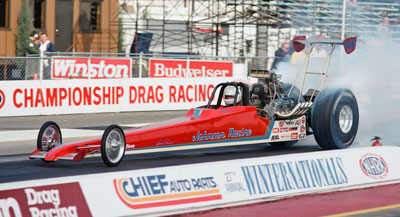 |
Speaking of Photo of the Week, Chris Barker, who works for Alan Johnson Performance Engineering, cleared up a few of my assumptions from my last Q&A column about the Alan and Blaine Johnson Alcohol Dragster featured in a recent Photo of the Week.
"I just discovered the pic of AJ at the '87 Winters and just about fell out of my chair. I came to work here later that same year and was the second employee at Johnson Racing (after
"This car was built by Alan and Blaine in a wood-framed tin-covered tractor barn on the family dairy farm. To this day, AJPE is still located on the family farm where the Johnson family was raised, just minus the 500 or so dairy cows! I believe that car was built specifically just for the asphalt. While they did have an earlier car that had won many races on the sand racing against Scelzi, Faria, Schedler, etc., it was not this car. That earlier sand drag car was also built by Alan and Blaine in the barn here on the farm, but I don't think this red car ever ran on the sand. AJ drove just about all of the time on the sand and also drove on the asphalt up till late '87 when
"Jim Rizzoli started his TAD racing career after purchasing this car from the Johnsons, who meanwhile had ordered a new car from some young unknown chassis guy named Brad Hadman. Hadman had come highly recommended by Walt and Pat Austin, who owned a Hadman-built TAFC. I believe it was the first or one of the first TADs that Brad built on his own after leaving Al Swindahl's shop. The Hadman car was the first TAD that the Johnson Racing family purchased, as Alan and Blaine had always built their own cars and engines themselves, and there were also a few other chassis that were built and sold to help pay for their own racing habit. Over the years, they received tuning help and moral support from experienced drag racers like Ora Vasquez and many others along the way, which kept them going and pointed in the right direction early on. I guess, as they say, the rest is history."
Thanks for the cleanup, Chris.

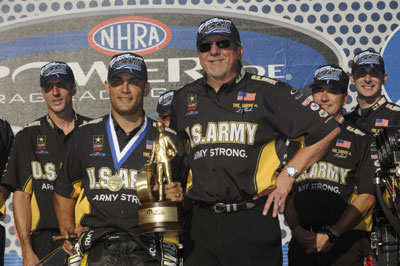 |
Q: I just have to say that although Tony Schumacher has had an outstanding year, I really do not think it is fair to give him the same record/title as Joe Amato; after all, Joe ran the quarter-mile for all of his victories, not 1,000 feet. Yes, Tony has only lost one race since the switch to 1,000 feet, but if you watch closely, that new finish line contributed greatly to some of his victories, including
A: It's not really the same thing, at least in my opinion, Barb. Anytime you start trying to compare two different eras of the same class, it's a slippery slope. The point is not the different distances but the fact that, like Amato, all of Schumacher's competitors were racing him to the same distance with the same set of rules, and his team just did a better job. When you consider all of the other things that have changed since Amato's glory days – nitro percentages, minimum weights, tires, etc. – it's clear that their two cars are fairly dissimilar, too. Who's also not to say that Amato didn't win some races because we ran to 1,320 instead of 1,000 feet back then; maybe it was his faster top-end charge that won him a lot of races in which he was behind at 1,000 feet.
This same discussion comes up whenever you try to compare Don Garlits to Amato. Amato has a lot more wins than "Big Daddy," but it doesn't make him a better Top Fuel racer. Amato won a lot of races in the era of double-digit races, and Garlits did most of his damage when the calendar had fewer than 10. For the record, they all get a piece of my "best Top Fuel" pie. Garlits, who built, tuned, and drove his own cars, is definitely the best Top Fuel racer. Amato, hands down, was the best Top Fuel operator/owner. Schumacher's team is, without question, the best one ever assembled in the history of the class.

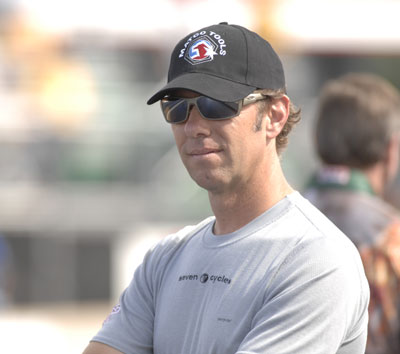 |
Q: So what's going on with Whit Bazemore these days? I actually had forgotten about him until I heard that Del Worsham got his new ride. That made me think about who was available, and Whit's name popped into my mind. -- Tim Boone,
A: I spoke to Whit just this morning at his home in
Although he would definitely entertain a return to the sport, he has nothing really in the fire, which actually kind of suits him fine.
"If I had to take a year off, this was a good one to do it," he said. "It was good timing. I miss the sport because I made so many good friends in the sport and with some of the fans. I certainly don’t miss the travel now because of my family, and being a racer requires you to be a bit selfish. It takes so much to do it, but, on the other hand, I don't think it ever leaves you. If the right situation comes along, I'd love to race; if it doesn't, I'm fine with that, too.
"I've talked to Don Schumacher a little bit, and if there's an opportunity I'd be very interested," he added. "Of course, with the way the economy is, it's awfully difficult now. I've talked to a couple of companies on a very preliminary basis, so who knows. Top Fuel or Funny Car, it doesn't really matter; for me, it's more about the people than the car."

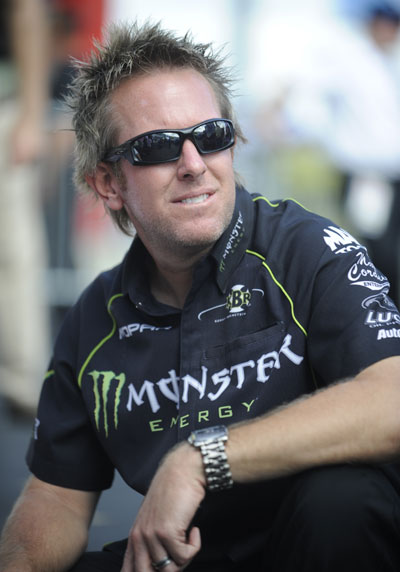 |
Q: During the Las Vegas coverage on TV, I believe it was Mike Dunn who said that Tommy Johnson Jr. was looking for a ride. There were no details given. There is no mention of this on the Web site. Since this has been made public, I think that his fans would appreciate some explanation if it is known. -- Dane Carney
A: When I spoke to team owner Kenny Bernstein a couple of weeks ago to get his remembrances of OCIR's Last Drag Race, the Bud King told me that he had told TJ that as of Sept. 1 he was free to look for other rides. Although Bernstein still was trying to put together deals to keep his Funny Car operation on the tour, he said that he felt that he owed it to Johnson to give him the opportunity to find a new ride after the tough and disappointing season they had together.
I caught up with TJ this morning as he was packing to come west, and he confirmed that he's definitely available and eagerly looking for a new ride, and the former Top Fuel driver doesn’t care if the engine is in front of him or behind.
"It doesn’t really matter to me; the only reason I switched to Funny Cars in the first place was because that was where the ride was," said Johnson, who moved from Top Fuel to Funny Car in 1999 to drive Joe Gibbs' Interstate Batteries Pontiac. "I have two or three things that I'm working on, but I'm ready to go if someone has the right deal. It's just been a miserable year, a year when nothing went right, and there have been plenty of times I've been aggravated with it. We've had a lot of self-inflicted mistakes -- some bad tuning decisions, mistakes in the pits, things like that -- but I tell myself that the people who really understand it know that it's not the driver's fault. Mike Kloeber has come in and done a good job the last couple of races, but it's too little too late.
"I hate this part of being a driver," he said of the uncertainty. "I was with Don Prudhomme for seven great years, so I don't like being unemployed."
TJ also confirmed that he has spoken to Alan Johnson about the still-officially-unfilled seat in his new Al-Anabi dragster. "We've definitely talked, even before he made his official announcement at Indy," said Johnson. "That would be my first choice, obviously. I think if you asked any driver which car he'd like to drive, it would be that one."

Q: Phil, I just wanted to let you know that Microsoft’s Live Maps works just fine for your ghost tracks also. You don’t even need to tweak under the hood to make it work. Just plug in the number, and away you go. http://maps.live.com. -- Tom Scott
A: Thanks, Tom. I've been checking it out recently – it goes by the brand name of Virtual Earth -- and indeed it's an impressive program and has some features that Google Earth doesn't, such as the Bird's-eye view as shown in the photo of Beeline Dragway in last Friday's column.
The good news for readers is threefold. First, it's free. Second, as Tom mentioned, you don’t have to reconfigure it to accept the coordinates I supply (though it's a quick and easy deal in Google Earth); you just plug them right into the search box. Third, it runs inside your browser, not as a stand-alone product like Google Earth.
 |
The third item is also a negative for me because though Google Earth is not dependent on an Internet connection, Microsoft's program is. The program can take some time to load; images were sometimes slow to download, and trying to "fly" around a neighborhood while in Bird's-eye view forces the program to constantly redraw it in both satellite and then Bird's-eye view.
Check out the image at right and then the two below. The one at right is your typical overhead satellite view. In 3-D mode (below left), you get a graphic approximation of the buildings it's attempting to show – in this case, your columnist's place of employment – but switching to Bird's-eye view (below right) really does the t
I haven’t really spent a lot of time with the program to give it a fair shake, but I can definitely see its usefulness, and if Bird's-eye coverage is expanded, it may become a better way to look at some old ghost-track sites, especially ones with buildings still standing.
 |
 |



















































